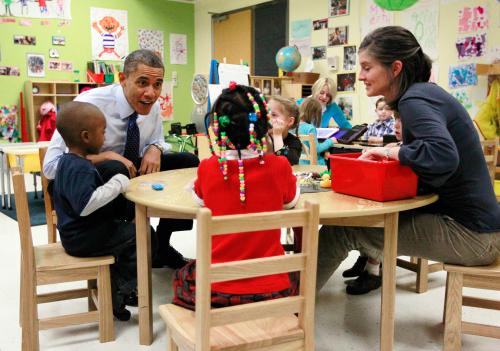A recent Brookings report reviewed the evidence on several specific issues related to public pre-K programs. These scaled-up state or district programs are intended to prepare four-year-olds for kindergarten. They are less intensive than the much smaller and heavily studied early childhood experiments, such as the Perry Preschool or Abecedarian programs, that have been shown to generate large long-term benefits relative to their costs.
I recommend the full report to interested readers, but draw here primarily on three of its chapters to reflect on the choice between universal versus targeted progams. I conclude that if limited resources rule out a universal program, then the best strategy may be to target pre-K services to disadvantaged communities rather than to disadvantaged children.
Reviewing the evidence
Recent national data document substantial gaps in readiness for kindergarten among groups of children defined by income or race or ethnicity. In particular, children from economically disadvantaged backgrounds are far less ready for kindergarten than their more advantaged counterparts, and black and Hispanic children are less prepared than white children. The extent to which disadvantaged children will benefit from public pre-K and how those benefits compare to those for their more advantaged counterparts are empirical questions.
In my chapter of the Brookings report, I review 13 high-quality, recent studies that examine effects of preschool programs by subgroup. I conclude not only that low-income children benefit from such programs, but typically they benefit more than their more affluent counterparts. The study designs vary, with some studies able to measure benefits only at kindergarten entry, while others are able to look at somewhat longer-run effects such as performance in first grade or above. Eight of the studies show differentially large effects for children from disadvantaged families.
Differential effects by racial or ethnic group are somewhat mixed and hard to sort out largely because of the high correlation between race and income. A few studies find large positive effects for Hispanic children, especially for dual language learners, presumably in part because pre-school gives them early access to English.
But do the social benefits of scaled up pre-K programs for disadvantaged children exceed the costs? In her chapter of the report, Lynn Karoly concludes that they do, provided that the programs are at least of moderate to high quality. Based on her review of studies of the Tulsa Universal pre-K program, and meta-analyses of Head Start and of state and district programs for low-income three- and four-year-olds, she finds positive benefit/cost ratios in the range of 2:1 to 4:1.
A number of points are worth noting. First, these benefit/cost ratios for scaled-up programs are much lower than the highly publicized ratios of seven or ten to one (or more) often cited for the small, targeted Perry Preschool and Abecedarian programs. Second, the costs per child are lower than those original small-scale programs but still high—for example, about $10,000 to $11,000 per child for a full-day program (in 2016 dollars). Further, the social benefits included in these calculations are those to all groups—participants, taxpayers, and others (e.g., in the form of crime reduction)—and not just to the state or local government that may be paying for the program.
In addition, the benefits accrue over time. While some benefits such as savings on special education may emerge in the relatively short term, others such as higher earnings and less antisocial behavior may not appear for 10 to 20 years. This long time frame poses a challenge both for program evaluators who must project uncertain benefits over time (but typically use standard methods to do so) and policymakers who typically would like to take credit for short-term benefits.
Finally, Karoly concludes that even though the evidence suggests that per-child economic returns are likely to be higher for disadvantaged children, the total net social benefits can still be higher for universal programs compared to targeted ones. That can happen because of the greater number of children who are generating positive benefits.
Choosing among policy options
William Gormley’s chapter of the report provides a useful overview of what is at stake in the choice between universal and targeted programs and clearly spells out the arguments for each option. Ultimately, he concludes that each individual state will have to determine which option is best given its values, its politics, the availability of resources, and the nature of other policy options that are on the table. I agree with Gormley’s discussion and conclusions but want to highlight three policy-relevant points here.
The first is that in addition to providing benefits to economically disadvantaged children, pre-K programs also provide benefits to middle-class children. That conclusion emerges from several of the subgroup studies I reviewed, and, most clearly, from the high-quality programs in Tulsa and Boston. This finding is important in that it means that a universal public pre-K program would not simply be substituting for programs that middle-class families would otherwise have provided to their children.
Second, as highlighted by Karoly, to be beneficial, pre-K programs must be of high quality. Hence, one must consider the likely relative quality of targeted or universal programs. For various reasons, universal programs may be of higher quality. One is that there may be positive peer effects for low-income children from being in pre-K classrooms with more advantaged children. Another is that a universal program may be able to attract higher-quality teachers, perhaps because the public may be more willing to invest in higher salaries for a program that benefits all children rather than just low-income children.
A recent careful, albeit non-causal, study by Elizabeth Cascio provides suggestive support for the higher quality of universal programs. She finds, for example, that economically disadvantaged children derive greater benefits from pre-K programs in states that offer universal programs than in those that offer targeted programs. Working in the other direction, though, one could well imagine that the higher total costs of a universal program may induce a state with limited resources to choose a targeted, high-quality program.
As Gormley points out, however, the choice is not simply between a universal program and a program targeted at disadvantaged children. States could, if they chose, start with a targeted program with the goal of moving to a universal program, could offer a high-quality universal program that is available to all four-year-olds with graduated fees for more affluent families, or could use geographic targeting rather than student targeting. A geographically targeted preschool program would be available to all children within the area regardless of family background.
Of these options for states or districts with limited resources, geographic targeting makes a lot of sense to me for the following reasons. It reduces the administrative hassles of having to identify which students are eligible for the program or what their fees should be, and also minimizes any potentially stigmatizing differences across children within a program. More importantly, it promotes the community-wide interest in making sure all neighborhood children are ready for kindergarten. That, in turn, facilitates the work of elementary school teachers and helps provide a subsequent school environment able to sustain the benefits of the pre-K program. Without that sustaining elementary school environment, some of the gains from investing in preschool programs are likely to dissipate.







Commentary
Weighing the benefits and costs of universal versus targeted pre-K programs
June 27, 2017